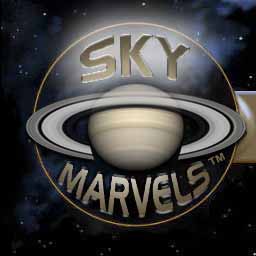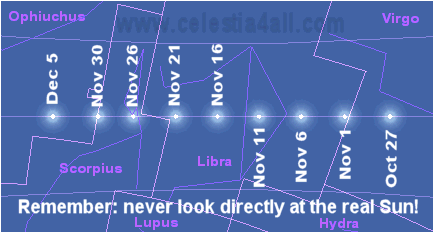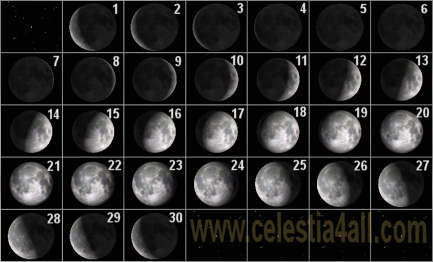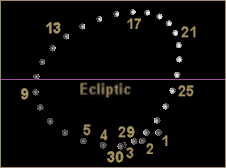








AVAILABLE MONTHS
2010:
Jan
Feb
Mar
Apr
May
Jun
Jul
Aug
Sep
Oct
Nov
Dec
2011:
Jan
Feb
Mar
Apr
May
Jun
ON NOV 7, TURN CLOCKS BACK
"STANDARD TIME" RESUMES ON NOV 7
It is time once again to turn U.S. clocks back an hour on Sunday, November 7, (so 3:00 AM becomes 2:00 AM, etc.) The maxim reminds us: "Spring Forward, Fall Back." So this time of year we "gain" the hour that we "lost" in the Spring.
APPARENT PATHS OF THE PLANETS
This month we see "speedy" Mercury in 4 constellations and (at one point) very close to Mars, while Saturn lingers in central Virgo.
Note: in the 1.6.x and 1.4.1 links in this column below, planets east ("left") of the Sun are visible in your sky after sunset, while planets west ("right") of the Sun are visible before sunrise.

MERCURY: 2010 Nov
This month Mercury occupies 4 different constellations (Libra, Scorpius, Ophiuchus and Sagittarius), as it "leads" the Sun to the east. On the 20th, Mercury appears only about three Moon diameters south of Mars (1.6.x) (1.4.1)
VENUS: 2010 Nov
In retrograde motion for the first half of November, Venus remains in Virgo for the whole month (1.6.x) (1.4.1). Another occultation of Venus by the Moon occurs on the 5th, but it will be very difficult to observe, as Venus appears only 12° from the Sun that day.
MARS: 2010 Nov
As it traverses Scorpius and Ophiuchcus, Mars continues eastward, "chased" by the Sun and Mercury (1.6.x) (1.4.1)
JUPITER, URANUS & NEPTUNE: 2010 Nov
Jupiter, Uranus and Neptune continue their retrograde motion as November begins. Uranus stays in Pisces and Neptune in Capricornus, while Jupiter remains in Aquarius (1.6.x) (1.4.1)
SATURN: 2010 Nov
Saturn moves slowly to the east in central Virgo for the whole month (1.6.x) (1.4.1)
CELES-TIPS
The following will help you enjoy this page's many links that run events directly in CELESTIA. If you're new to the program, these tips will also help you learn to use it.
- If CELESTIA's clock (i.e. the program's date and time) is not visible at the top right of its window, press the V key until you see it. This will also turn on information text in other corners as well. This text will help you keep track of several aspects of the event you're viewing.
- Pressing the "un-shifted" L key and K key respectively will speed up and slow down CELESTIA's flow of time by a factor of 10 in version 1.6.x and 1.4.1.
- Pressing Shift+L and Shift+K respectively will speed up and slow down CELESTIA's flow of time by a factor of 2 in version 1.6.x only.
- Pressing the J key (either shifted or "un-shifted") will reverse CELESTIA's flow of time in version 1.6.x and 1.4.1.
You'll find more information about many of CELESTIA's controls on our Learning Center page.
NEW ON OUR "BONUSES" PAGE
FREE ECLIPTIC & ZODIAC ADD-ON
Download our free "Ecliptic ∓ Zodiac Add-on" right here or, if you would like more information about it, go to our Bonuses page and download the add-on there. This adds the excellent "celestial signposts" of the Ecliptic and the Zodiac to CELESTIA to help guide you on your journeys through the cosmos! Enjoy!
COMING NEXT MONTH
BEST LUNAR ECLIPSE SINCE 2007 AUG
On December 21, Earth will witness its best Total Lunar Eclipse since 2007 August. Here is a preview of what to expect (1.6.x) (1.4.1). Our News page for the month of December will feature a video that highlights this lunar eclipse, which—weather-permitting—will be able to be viewed particularly well in the western hemisphere.
THE SUN
APPARENT PATH OF THE SUN: 2010 Nov
Here are the Sun's positions along the Ecliptic at 00:00 UTC on the days shown.

The slightly curved lines above and below the Ecliptic show the extent of the Zodiac, which you may download from our Bonuses page and add to any version of CELESTIA. Note that the curve in the Zodiac lines is the result of CELESTIA's rendering in perspective.
 W A R N I N G ! It is never safe to look directly at the real Sun with the naked eye! Moreover, looking at it through a telescope or binoculars—even for an instant—can cause permanent blindness! NEVER DO IT! Consult the professionals at your local planetarium or observatory to learn how you can safely "observe" the Sun and any SOLAR eclipse!
W A R N I N G ! It is never safe to look directly at the real Sun with the naked eye! Moreover, looking at it through a telescope or binoculars—even for an instant—can cause permanent blindness! NEVER DO IT! Consult the professionals at your local planetarium or observatory to learn how you can safely "observe" the Sun and any SOLAR eclipse!
Of course, you can safely view CELESTIA's depiction of the Sun's apparent path in the sky in November. Here are the links: (1.6.x) (1.4.1). Note that versions 1.6.x and 1.4.1 differ in the way their "follow" and "lock" features work. If you "follow" Earth and then "lock" the Sun to it, versions 1.6.x and 1.4.1 respectively maintain the "attitudes" of the Ecliptic and the the Celestial Equator. This means that the Ecliptic remains "level" when you run the first link, but begins to tilt when you run the second! Differences like this will be discussed on our Help page.
HALF OF EARTH IN SUNLIGHT & DARKNESS
During your voyages in CELESTIA, would you like to be able to position yourself directly over the center of the half of Earth in sunlight or the half in darkness at any time this month? On our Tips page, you'll find that it's quite easy to do so! If you're any kind of sky watcher at all, you probably know just how helpful this can be!
THE MOON
PHASES OF THE MOON: 2010 Nov
In UTC per CELESTIA 1.6.x (& 1.4.1):
New: Nov 6, 4:52 (4:53). 1st Qtr: Nov 13, 16:39 (16:40).
Full: Nov 21, 17:28 (17:29). Last Qtr: Nov 28, 20:37 (20:38).
NOTE: New, 1st Quarter, Full and Last Quarter Moons respectively are defined to occur when the Geocentric Ecliptic Longitudes of the Moon and the Sun differ by 0°, 90°, 180° and 270°.
To watch a short video demonstrating the Phases of the Moon, click here.

The above diagram is produced with our "Moon Phases Calendar" script. The numbers of the days of the month were added with an image-editing program.
To watch a short video of our Moon Phases Calendar in action, click here.
LUNAR APOGEE & PERIGEE: 2010 Nov
Per CELESTIA 1.6.x (and 1.4.1):
Perigee: Nov 3, 17:26 (17:27) UTC; 364,204 km.
Apogee: Nov 15, 11:50 (11:51) UTC; 404,628 km.
Perigee: Nov 30, 19:06 (19:07) UTC; 369,436 km.
Determined by our "Earth-Moon Distance" and "Moon's Apparent Path" scripts. Note that distances given are the distances between Earth's and the Moon's centers.
LUNAR ANALEMMA: 2010 Nov
Here is the lunar analemma, generated by the Moon's positions relative to the mean lunar orbit and the Ecliptic at 0:00 UTC every day of November.

This phenomenon can be observed using our "Moon's Apparent Path" script. The analemma's change of shape month after month begins to give us an idea of just how irregular the lunar orbit is.
Donate safely with: PayPal
to receive one or more
Sky-Gifts. Your support is greatly appreciated!
Various astronomical "shadow events" occur throughout the Solar System! This month's more interesting ones are featured here.
SHADOW WORKS
Here we highlight the most awe-inspiring eclipses taking place in our Solar System. We also set them up so that all you need to do is click on their links. Don't forget that you can generate lists of Earth's, Jupiter's, Saturn's, Uranus's, Neptune's and even Pluto's eclipses, using CELESTIA's own built-in "Eclipse Finder." You'll find it in the program's menu under "Navigation".
All events listed below are displayed as if viewed from Earth, their magnifications shown in parentheses at the lower right of CELESTIA's window. Events involving more than one moon are often cyclical, so usually only the first example is given, and then the period of the cycle.
Remember: you can press the M key to toggle Moon Labels on and off .
 JUPITER
JUPITER
Simultaneous solar eclipses occur this month on Jupiter, but hey are not as dramatic as last month's events. Two or more Galileans visible at various times near Jupiter in November nonetheless give sky-watchers a treat. Below are highlights of the 31 solar eclipses which Io, Europa, Ganymede and Callisto are responsible for this month. Jupiter's shadow stretches eastward (to the left) this month, as it has done since its opposition with the Sun in late September. Examples of some Galileans moving into or emerging from the Jovian shadow are included.
- Nov 1: Io "chases" Europa behind Jupiter, as it will do now about every 3½ days (1.6.x) (1.4.1)
- Nov 3: all four Galileans can be seen near Jupiter (1.6.x) (1.4.1)
- Nov 4: Io and Callisto cast their shadows on Jupiter's Southern Hemisphere at the same time (Callisto's near Jupiter's south pole) (1.6.x) (1.4.1); here's a better view of the shadows from near Jupiter (1.6.x) (1.4.1)
- Nov 7: Europa's shadow precedes Ganymede's, producing their first of 2 simultaneous ("double") solar eclipses this month (1.6.x) (1.4.1)
- Nov 10: Three Galileans near Jupiter; cycle repeats about every 7 days (1.6.x) (1.4.1)
- Nov 11: Three Galileans near Jupiter, with Callisto "grazing" its north pole (1.6.x) (1.4.1)
- Nov 14: Europa's shadow precedes Ganymede's, barely producing their 2nd simultaneous ("double") solar eclipses this month (1.6.x) (1.4.1)
 SATURN
SATURN
While CELESTIA 1.6.x shows the shadows of Titan, Rhea, Iapetus, Dione and Tethys, version 1.4.1 displays only the shadows of Titan, Rhea & Iapetus. So, 1.6.x and 1.4.1 respectively show 27 and no solar eclipses on Saturn in November. Version 1.6.x reveals a few simultaneous solar eclipses.
- Nov 1: Tethys casts its shadow in Saturn, as it currently does about every 2 days; (1.6.x only)
- Nov 2: Dione casts its shadow on Saturn, as it currently does about every 2¾ days; (1.6.x only)
- Nov 5: Dione and Tethys cast their shadows on Saturn simultaneously (1.6.x only)
- Nov 29: Tethys and Dione cast their shadows on Saturn simultaneously (1.6.x only)
URANUS, NEPTUNE & Dwarf Planet PLUTO
Neither Uranus nor Neptune will experience eclipses for decades. Dwarf planet Pluto will experience no eclipses by Charon for about a century!
Back to Top
Home Intro News Gallery Sky-Gifts Bonuses Tips
Learning Ctr Help Links Credits Legal Contact Us
© 2007-
by Gary M. Winter. All rights reserved.
Interested in political cartoons and humor?
Check out The HIPPLOMATS™.
SkyMarvels, SkyMarvels: Your Key to the Sky and the Universe! Sky Marvels, SkyMarvels.com, celestia4all, celestiaforall, CELESTIA, astronomy, space, simulations, animations, downloadable astronomy posters, stars, planets, Inner Planets, Outer Planets, Inferior Planets, Superior Planets, moons, asteroids, comets, Oort Cloud, galaxy, galaxies, Milky Way, Andromeda, globular clusters, binaries, quasars, black holes, supermassive black holes, telescope, telescopes, planetarium, software, freestuff, satellites, add-ons, addons, scripts, eclipses, Solar Eclipses, Lunar Eclipses, Solar Eclipse Finder, Lunar Eclipse Finder, mutual eclipses, transits, occultations, Solar System, CELES-TOOLS, celeSTARrium, CELX, CELX programming, Freebies, Bonuses, multiple views, atronomical unit, light year, parsec, meteors, meteor showers, Perseids, Geminids, Leonids, barycenter, time, Time Zones, tides, alignments, conjunctions, oppositions, seasons, apogees, perigees, aphelion, perihelion, Earth, Luna, Mercury, Venus, Mars, Jupiter, Galilean Moons, Io, Europa, Ganymede, Callisto, Saturn, Titan, rings, Uranus, Neptune, Triton, E-MSpectrum, electromagnetic spectrum, astronaut, equinoxes, solstices, precession, rotation, spin, inclination, tilt, Ecliptic, orbits, ellipse, parabola, hyperbola













